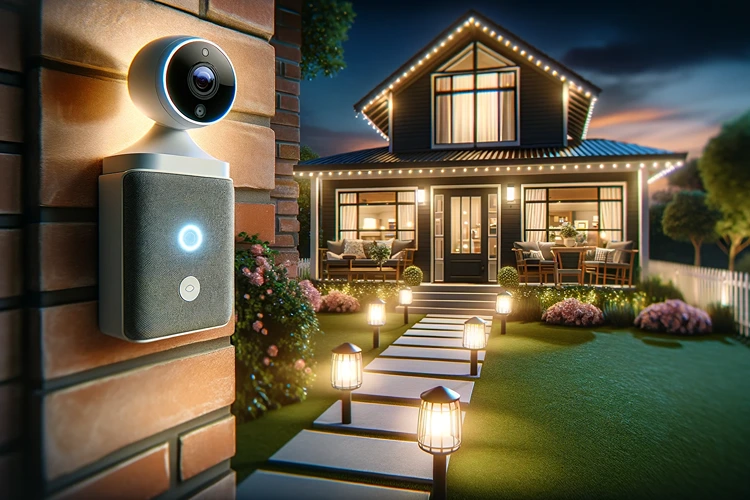Building Homes with Voice-Controlled Technology

The concept of a home that listens and acts upon your voice commands is no longer confined to the realms of science fiction.
Voice-controlled technology is transforming our living environments into smart ecosystems, capable of offering unprecedented convenience and efficiency.
This article explores the integration of voice-controlled technology in home building, showcasing how this modern marvel can enhance everyday living.
The Evolution of Smart Home Technology
The journey from manual switches to voice-activated homes signifies a remarkable leap in technology. Voice control serves as the pinnacle of this evolution, offering a seamless interface between humans and machines.
It’s not merely about controlling lights or thermostats; it’s about creating a cohesive system that enhances the quality of life for its inhabitants.
Core Elements of Voice-Controlled Home Systems
At the heart of a voice-controlled home are several key components that work in harmony to bring the convenience of voice command to life.
Smart Speakers and Virtual Assistants
The foundation of any voice-controlled home is the smart speaker, powered by virtual assistants like Amazon Alexa, Google Assistant, and Apple Siri. These devices serve as the central hub for voice interaction, processing commands, and controlling various smart home devices.
Connected Devices and Appliances
From smart bulbs and thermostats to advanced security systems and kitchen appliances, a wide range of devices can be integrated into the voice-controlled ecosystem.
These devices are designed to communicate with each other and the central hub, creating a network of voice-activated control.
Home Automation Systems
Beyond individual devices, comprehensive home automation systems can orchestrate multiple functions across the home. These systems enable complex scenarios, like setting the perfect ambiance for movie night with a single voice command that dims the lights, lowers the blinds, and turns on the TV.
Planning and Designing for Voice Control
Incorporating voice control into home design requires meticulous planning. Architects and designers now consider the placement of microphones, speakers, and connectivity infrastructure to ensure optimal functionality of voice-controlled systems.
Acoustic Design
Understanding acoustics is essential for effective voice command detection. Strategic placement of devices in relation to room acoustics and minimizing echo can significantly enhance voice recognition accuracy.
Connectivity and Integration
A robust and reliable Wi-Fi network is crucial for the seamless operation of voice-controlled devices. The integration of different devices and ensuring they can communicate effectively is also a key design consideration.
Advantages of Voice-Controlled Homes
The allure of voice-controlled homes lies in their vast array of benefits, which extend beyond mere convenience.
Enhanced Accessibility
For individuals with mobility challenges or visual impairments, voice-controlled technology offers a level of independence and accessibility previously unattainable.
Energy Efficiency and Savings
Smart thermostats and lighting controlled by voice commands can lead to significant energy savings, reducing utility bills and environmental impact.
Security and Peace of Mind
Voice-controlled security systems enhance home safety, allowing homeowners to monitor, alert, and respond to potential threats with ease.
Helpful Hint:
When planning a voice-controlled home, consider creating scenarios or routines that automate multiple tasks with a single command, such as a “good night” routine that secures the house, turns off lights, and adjusts the thermostat.
Implementing Voice Control in Your Home
Transforming your home into a voice-controlled smart home might seem daunting, but it’s achievable with proper planning and the right tools.
Choosing the Right Ecosystem
Selecting a voice assistant ecosystem (Amazon Alexa, Google Assistant, or Apple Siri) is the first step. This choice will dictate the compatible devices and services for your home.
Device Compatibility and Interoperability
Ensuring that all your smart devices are compatible with your chosen ecosystem is crucial for a seamless voice-controlled experience.
Installation and Configuration
While many smart devices are designed for DIY installation, considering professional help for complex setups can ensure optimal performance and integration.
Navigating Challenges and Privacy Concerns
Despite the advantages, the adoption of voice-controlled technology comes with its set of challenges, including privacy concerns and the potential for misuse. Ensuring data protection and securing your home network are essential steps in mitigating these risks.
Looking Ahead: The Future of Voice-Controlled Homes
As technology advances, we can anticipate even more sophisticated voice-controlled systems. Developments in AI and machine learning will lead to more intuitive interactions, making the technology blend even more seamlessly into our lives.
FAQs
Bottom Line
Embracing voice-controlled technology in home building is not just about embracing the future; it’s about redefining the present.
This dynamic technology offers a blend of convenience, security, and efficiency, tailored to the modern homeowner’s needs.
As we continue to innovate and integrate these systems into our homes, the essence of what it means to live in a connected, responsive environment will evolve.
Voice-controlled technology is not merely an addition to our homes; it’s becoming the backbone of how we live, interact, and enjoy our personal spaces.
Additional Resources:
- Google Assistant Official Site: Learn about Google Assistant and how it integrates with various smart home devices to help you control your home with just your voice. Whether it’s managing tasks, controlling smart appliances, or getting answers, Google Assistant makes it easy. https://assistant.google.com/
- Apple HomeKit: Discover how Apple HomeKit enables secure and easy control of your smart home products using Siri and Apple devices. HomeKit is designed for user-friendly home automation, from lighting to security, all controllable through voice commands or the Home app. https://www.apple.com/ios/home/
- SmartThings by Samsung: SmartThings brings your home to life with smart devices and services. Learn how to control, monitor, and secure your home from anywhere and make your home smart with voice commands. https://www.smartthings.com/


